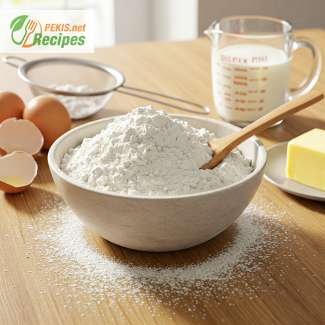
Understanding Cake Flour: Composition, Uses, and Benefits
What Is Cake Flour?
Cake flour is a finely milled, low-protein wheat flour specifically designed for making cakes and other delicate baked goods. Unlike all-purpose flour, cake flour contains less gluten, giving baked goods a softer, more tender crumb. It is commonly used in recipes that require a light and airy texture, such as sponge cakes, chiffon cakes, and angel food cakes.
Characteristics of Cake Flour
Cake flour is distinct from other types of flour due to several key characteristics:
- Low Protein Content: Typically, cake flour contains 6-8% protein, significantly lower than all-purpose flour, which has around 10-12%.
- Fine Texture: It is milled to a much finer consistency than all-purpose flour, allowing for a smoother batter and better incorporation of ingredients.
- High Starch Content: The higher starch content absorbs more liquid, creating a more stable batter and a softer crumb.
- White Color: Cake flour is often bleached, which weakens the gluten structure and enhances its ability to absorb liquids.
- Lightweight and Fluffy: The fine texture and lightness help cakes rise properly without becoming dense.
Why Is Cake Flour Used in Baking?
Cake flour is preferred in baking because of its ability to create soft, tender, and moist cakes. Some key reasons why bakers choose cake flour include:
- Reduces Gluten Development: Less protein means less gluten formation, resulting in a delicate structure.
- Enhances Moisture Retention: The high starch content helps retain moisture, preventing cakes from drying out.
- Improves Cake Volume: The light texture and fine particles help cakes rise evenly.
- Creates a Finer Crumb: Cakes made with cake flour have a softer, melt-in-your-mouth quality compared to those made with all-purpose flour.
How to Use Cake Flour in Baking
Cake flour is ideal for recipes that require a light and airy texture. Here’s how you can use it effectively:
- Measuring Properly: Always sift cake flour before measuring to prevent compacting, which could lead to excessive flour in a recipe.
- Substituting for All-Purpose Flour: If a recipe calls for cake flour but you only have all-purpose flour, replace 1 cup of cake flour with 1 cup of all-purpose flour minus 2 tablespoons, plus 2 tablespoons of cornstarch.
- Best Used in: Cakes, cupcakes, muffins, pancakes, waffles, and some delicate pastries.
How Cake Flour Works in Baking
The science behind cake flour’s effectiveness lies in its low gluten formation. Gluten is a protein that provides structure to baked goods, but too much of it can make cakes dense and tough. The lower protein content in cake flour allows cakes to remain soft and tender.
When mixed with liquids, cake flour absorbs moisture quickly, helping to create a smooth batter. Because it has a high starch-to-protein ratio, it also helps cakes retain their shape while preventing them from collapsing.
Secrets to Using Cake Flour Effectively
To get the most out of cake flour, follow these expert tips:
- Always Sift the Flour: This ensures even distribution and a lighter texture.
- Use the Right Liquid Ratio: Because cake flour absorbs more liquid, you may need to slightly increase the moisture in some recipes.
- Avoid Overmixing: Overmixing activates gluten, leading to tougher cakes.
- Pair With the Right Leavening Agents: Cake flour works best with baking powder and egg whites to achieve an airy texture.
- Store Properly: Keep cake flour in an airtight container in a cool, dry place to prevent it from absorbing moisture from the air.
Why Is Cake Flour Perfect for Recipes?
Cake flour makes an enormous difference in the final texture of baked goods. Here’s why:
- Soft and Light Texture: Results in a more delicate crumb compared to all-purpose flour.
- Enhances Flavor Absorption: Cakes made with cake flour absorb flavors better, making them more delicious.
- Prevents Overly Dense Cakes: Because it has less protein, cakes remain fluffy and soft rather than becoming dense and chewy.
Health Benefits of Cake Flour
While cake flour is primarily used for texture, it also offers some nutritional benefits:
- Lower in Gluten: Ideal for those who want to reduce gluten intake.
- Contains Essential Nutrients: Many brands of cake flour are enriched with vitamins and minerals.
- Easier to Digest: Because of its lower gluten content, it is often easier on digestion compared to high-protein flours.
Vitamins and Nutrients in Cake Flour
Depending on the brand, cake flour may be enriched with:
- Iron: Supports healthy blood circulation.
- Folic Acid: Essential for cell growth and development.
- Niacin (Vitamin B3): Helps convert food into energy.
- Riboflavin (Vitamin B2): Important for metabolism and energy production.
- Thiamine (Vitamin B1): Supports nervous system function.
Other Essential Information About Cake Flour
- Can You Use Cake Flour for Cookies? Yes! If you want lighter, softer cookies, cake flour is a great option.
- What Happens If You Use Cake Flour Instead of All-Purpose Flour? Your baked goods will be softer and fluffier with a more delicate crumb.
- Is Cake Flour Gluten-Free? No, but it contains less gluten than regular flour.
- Can You Make Bread with Cake Flour? It’s not recommended, as it lacks the protein needed for a chewy texture.
Is Cake Flour Worth Using?
Absolutely! If you want to achieve bakery-quality cakes at home, cake flour is a must-have ingredient. Its low protein content, fine texture, and superior moisture absorption make it perfect for creating soft, tender cakes that melt in your mouth.
By using cake flour correctly, following the right measuring techniques, and understanding how it interacts with other ingredients, you can significantly improve your baking results. Whether you’re making a classic vanilla sponge cake, moist chocolate cupcakes, or fluffy pancakes, cake flour will elevate the texture and taste of your baked goods.